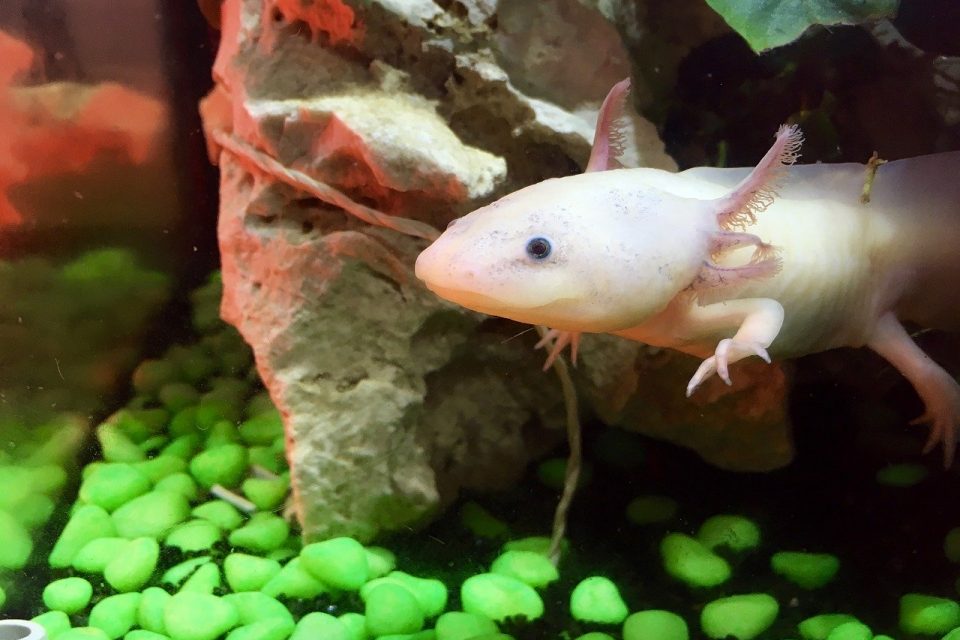
What Is an Axolotl?
Axolotls have captured the imagination of biologists and science enthusiasts alike. These endangered amphibians can be extremely hard to find, and, unfortunately, may not be around forever. Today, let’s take a deeper dive: what is an axolotl?
Amphibian Taxonomy
The axolotl goes by many names. Scientifically, it is referred to as Ambystoma mexicanum. More commonly, it’s called the Mexican walking fish. But, this is a misnomer. While axolotls do in fact walk, they are not fish. They are part of the class Amphibia, meaning that they are amphibians.
The genus that axolotls are part of, Ambystoma, contains 32 species. Collectively, they are referred to as the “mole salamanders.” Aside from the axolotl, the most famous member of this genera is the tiger salamander. Oddly enough, the tiger salamander is the state amphibian of several different states including Colorado and Kansas.
Morphology and Biology
Several key characteristics identify axolotls. Due to their relatively restricted habitat (more on that later), most axolotls look very similar.
- Body size: these are large amphibians! To many people, axolotls may look like very large salamanders, as they are usually around 9 inches long.
- Eyes: like all mole salamanders, axolotls have “buggy”, protruding eyes. They lack lids and are almost always black in color.
- Gills: external gills are possibly the easiest identifier of an axolotl. This strange, stringy organ hangs off the back of the amphibian’s neck, almost like a colorful necklace.
Most axolotls on planet earth are in captivity. Because of this, relatively little is known about the specific habits and group dynamics of wild axolotls. That said, we do know several interesting things about their wild behavior.
- Predators: axolotls are born hunters. While they will usually hide during the day, axolotls come out at night to feed on small crustaceans, fish, and worms.
- Suction eating: the salamanders are capable of sucking up worms and small prey through the mud and gravel of their habitat. Incidentally, they will often take in small bits of gravel and sand. This isn’t harmful to the axolotl, in fact, it is a necessary step for successful digestion.
- Parental care: like almost all salamanders, the parents do almost nothing to care for their young. The father is only present for mating.
Coloration
The different colors of axolotls have been the topic of intense genetic research. Researchers from the University of Kansas and Indiana University have been studying this topic for several years. They state that “Four genes are known to affect pigmentation in the Mexican axolotl.” Each one of these genes is recessive. Almost certainly, this is what produces the interesting variety of different colors that we today.
- Wild Type: this is the most common coloration of axolotls. Their skin is generally dark, ranging from dark olive-green to almost black. On top of the dark coloration, these types of amphibians also have small golden or silver flecks. This tends to give them a sort of mottled appearance.
- Melanoid: the only difference is that the melanoid coloration lacks the gold or silver flecks and is thus entirely dark. Due to this, it can be easy to confuse the wild type coloration with melanoid.
- Axunthic: this is another phenotype that can be difficult to distinguish. Axunthic coloration is the result of the lack of a gene that helps to produce and store yellow pigment. As such, these axolotls tend to look more blue than green but are still largely dark.
- Albino: this one mostly speaks for itself. Albino axolotls are unable to produce any pigment and are thus white.
- White: somewhat surprisingly, this is different than albino. Whereas the albino phenotype lack the ability to produce pigment, white axolotls actually produce white pigment. This causes them to be a more pure color or white.

Image by KinEneiquez via Pixabay
Axolotl Habitat
Axolotls are only native to a small portion of Mexico. Presently, they live in a single lake just south of Mexico City: Lake Xochimilco. As of 2020, the lake exists as a series of canals that run near the outskirts of town. Previously, Xochimilco was much larger, and it was actually a series of lakes.
According to researchers at the Universidad Nacional Autonoma de Mexico, the axolotls “have seen alarming decline in the last decades owing to habitat loss caused by urban growth.” Additionally, In recent surveys of their populations, a staggeringly low count of 23 axolotls were caught for monitoring and release. This number is down from several thousand only a few decades ago.
Growth and Regeneration
Axolotls are the subject of intense biology research. This is primarily due to their unique ability to regenerate parts of their body. Various studies have shown that the salamanders have the ability to regrow most parts of their body, even if the entire limb was removed. Axolotls have been shown to regenerate eyes, legs, feet, parts of their heart, and even parts of their brain. This makes them a unique animal model to understand growth and development in humans.
Featured image by uthlas via Pixabay.
Check us out on EarthSnap, a free app brought to you by Eric Ralls and Earth.com.













